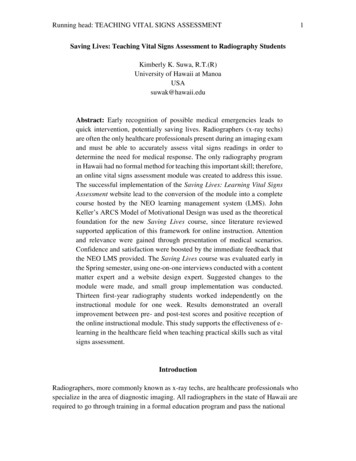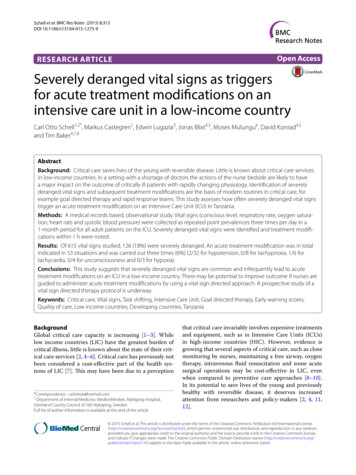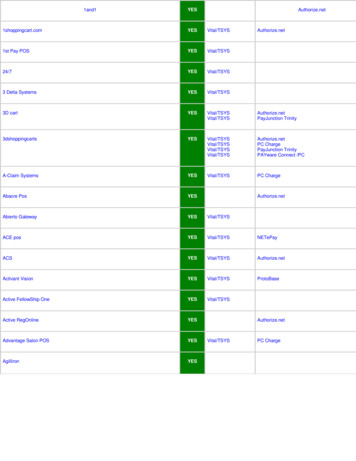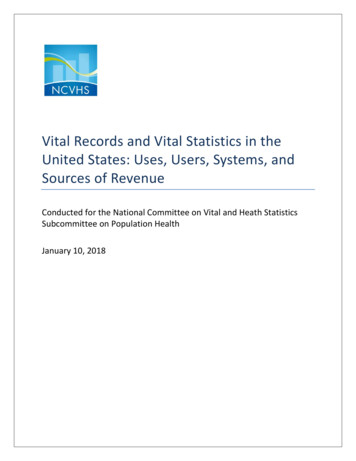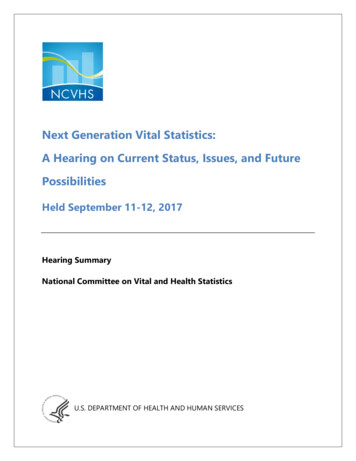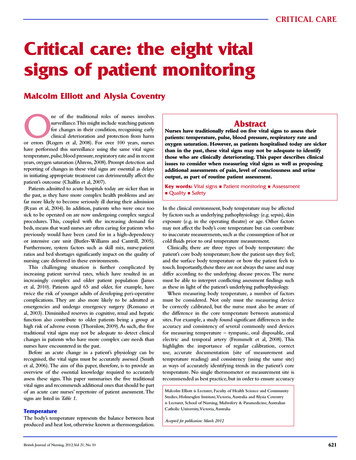
Transcription
CRITICAL CARECritical care: the eight vitalsigns of patient monitoringMalcolm Elliott and Alysia CoventryOne of the traditional roles of nurses involvessurveillance.This might include watching patientsfor changes in their condition, recognising earlyclinical deterioration and protection from harmor errors (Rogers et al, 2008). For over 100 years, nurseshave performed this surveillance using the same vital signs:temperature, pulse, blood pressure, respiratory rate and in recentyears, oxygen saturation (Ahrens, 2008). Prompt detection andreporting of changes in these vital signs are essential as delaysin initiating appropriate treatment can detrimentally affect thepatient’s outcome (Chalfin et al, 2007).Patients admitted to acute hospitals today are sicker than inthe past, as they have more complex health problems and arefar more likely to become seriously ill during their admission(Ryan et al, 2004). In addition, patients who were once toosick to be operated on are now undergoing complex surgicalprocedures. This, coupled with the increasing demand forbeds, means that ward nurses are often caring for patients whopreviously would have been cared for in a high-dependencyor intensive care unit (Butler-Williams and Cantrill, 2005).Furthermore, system factors such as skill mix, nurse:patientratios and bed shortages significantly impact on the quality ofnursing care delivered in these environments.This challenging situation is further complicated byincreasing patient survival rates, which have resulted in anincreasingly complex and older patient population (Jameset al, 2010). Patients aged 65 and older, for example, havetwice the risk of younger adults of developing peri-operativecomplications. They are also more likely to be admitted asemergencies and undergo emergency surgery (Romano etal, 2003). Diminished reserves in cognitive, renal and hepaticfunction also contribute to older patients being a group athigh risk of adverse events (Thornlow, 2009). As such, the fivetraditional vital signs may not be adequate to detect clinicalchanges in patients who have more complex care needs thannurses have encountered in the past.Before an acute change in a patient’s physiology can berecognised, the vital signs must be accurately assessed (Smithet al, 2006). The aim of this paper, therefore, is to provide anoverview of the essential knowledge required to accuratelyassess these signs. This paper summarises the five traditionalvital signs and recommends additional ones that should be partof an acute care nurses’ repertoire of patient assessment. Thesigns are listed in Table 1.TemperatureThe body’s temperature represents the balance between heatproduced and heat lost, otherwise known as thermoregulation.British Journal of Nursing, 2012, Vol 21, No 10 AbstractNurses have traditionally relied on five vital signs to assess theirpatients: temperature, pulse, blood pressure, respiratory rate andoxygen saturation. However, as patients hospitalised today are sickerthan in the past, these vital signs may not be adequate to identifythose who are clinically deteriorating. This paper describes clinicalissues to consider when measuring vital signs as well as proposingadditional assessments of pain, level of consciousness and urineoutput, as part of routine patient assessment.Key words: Vital signs n Patient monitoring n Assessmentn Quality n SafetyIn the clinical environment, body temperature may be affectedby factors such as underlying pathophysiology (e.g. sepsis), skinexposure (e.g. in the operating theatre) or age. Other factorsmay not affect the body’s core temperature but can contributeto inaccurate measurements, such as the consumption of hot orcold fluids prior to oral temperature measurement.Clinically, there are three types of body temperature: thepatient’s core body temperature; how the patient says they feel;and the surface body temperature or how the patient feels totouch. Importantly, these three are not always the same and maydiffer according to the underlying disease process. The nursemust be able to interpret conflicting assessment findings suchas these in light of the patient’s underlying pathophysiology.When measuring body temperature, a number of factorsmust be considered. Not only must the measuring devicebe correctly calibrated, but the nurse must also be aware ofthe difference in the core temperature between anatomicalsites. For example, a study found significant differences in theaccuracy and consistency of several commonly used devicesfor measuring temperature – tympanic, oral disposable, oralelectric and temporal artery (Frommelt et al, 2008). Thishighlights the importance of regular calibration, correctuse, accurate documentation (site of measurement andtemperature reading) and consistency (using the same site)as ways of accurately identifying trends in the patient’s coretemperature. No single thermometer or measurement site isrecommended as best practice, but in order to ensure accuracyMalcolm Elliott is Lecturer, Faculty of Health Science and CommunityStudies, Holmesglen Institute, Victoria, Australia and Alysia Coventryis Lecturer, School of Nursing, Midwifery & Paramedicine, AustralianCatholic University, Victoria, AustraliaAccepted for publication: March 2012621
Table 1. Eight vital signsVital led byAgethe hypothalamusInfectionMedicationsPulseReflects circulatingIntravascularvolume andvolumestrength ated byIntravascularpressurevasomotor centrevolumein the medullaVascular toneContractilityRespiratoryControlled by theHypercapniaraterespiratory centresHypoxaemiain the medullaAcidosisand ponsSpO2Reflects theCardiac outputperipheralHemoglobinsaturation oflevelhaemoglobin byFraction ofO2inspired O2PainDetected byPatient’speripheral nerveperceptionfibers; interpretedby thalamus andcerebral cortexLevel ofControlled byCerebralconsciousness reticular activatingperfusionsystem in thebrain stemUrine outputProduced byRenalkidneysperfusionCardiac OutputAssessment issuesCore temperature differsbetween anatomical sitesShould be counted for atleast 30 seconds.Regularity, strength andequality should also beassessedAutomated monitors areless reliable than asphygmomanometerIndications for measuring:to establish a baseline;critical illness, a change inoxygenation, to evaluateresponse to treatmentDoes not reflectrespiratory functionoverallOften under-assessed andtreated in hospitalInfluenced by intra-cranialand extra-cranial factorsDoes not directly reflectrenal functionand safe practice, the nurse must be aware of these factors.PulsePulse is defined as the palpable rhythmic expansion of anartery produced by the increased volume of blood pushed intothe vessel by the contraction and relaxation of the heart (Piper,2008). The pulse is affected by many factors including age,existing medical conditions (e.g. fever), medications (e.g. betablockers) and fluid status (e.g. hyper/hypovolaemia). Nursesshould be aware that the pulse is not always a true reflectionof cardiac contractility or output; in the case of aortic stenosis,for example, the pulse may be weak in spite of forceful cardiaccontractions (Smith et al, 2008).Pulse should also not be considered the same as heart rate,which is actually a measurable pulse characteristic. When thepulse is palpated, characteristics other than rate also need tobe assessed. These include the strength or amplitude of thepulse, peripheral equality of pulses and the pulse’s regularity.These provide the nurse with further insight into the patient’scondition or response to clinical treatment.There is debate in the literature about whether a pulse shouldbe assessed for 15 seconds or longer. Counting the pulse for622 30 seconds or less is potentially problematic as an irregular pulsemay not be detected during this interval. Using a short timeperiod, such as this, has also been shown to increase calculationerrors four to six fold (Minor and Minor, 2006). A patient withatrial fibrillation, for example, may appear to have a regularpulse if it is assessed for 30 seconds or less. Assessing the pulsefor a full 60 seconds may, therefore, highlight abnormalities notdetected during a shorter assessment interval. However, thecontradictory findings of studies reporting on the relationshipbetween the length of pulse assessment and accuracy, suggestthat the count period is only of limited significance (JoannaBriggs Institute, 1999).Nurses should not rely on a pulse oximeter to determine apatient’s pulse rate. Rather, they should use their knowledgeand physical assessment skills to accurately assess the pulse.For example, if the pulse is irregular or the patient is cold orhypovolaemic, a pulse oximeter may provide an inaccuratereading. Reliance on technology for taking observations maybe detrimental to patient care, as other obvious clues to thepatient’s condition can be easily missed (Wheatley, 2006). Inaddition, using a machine (e.g. pulse oximeter) to measurea physiologic parameter may limit the amount of time thenurse spends with the patient, both talking to them andtouching them, missing the opportunity to identify furthervaluable clinical data.Blood pressureBlood pressure (BP) refers to the pressure exerted by bloodagainst the arterial wall. It is influenced by cardiac output,peripheral vascular resistance, blood volume and viscosity andvessel wall elasticity (Fetzer, 2006). BP is an important vitalsign to measure as it provides a reflection of blood flow whenthe heart is contracting (systole) and relaxing (diastole). It isalso one of many indicators of cellular oxygen delivery.Changes or trends in BP may reflect underlyingpathophysiology or the body’s attempts to maintain homeostasis.A drop in BP, for example, has been found to be a commonsign in patients prior to cardiac arrest (Rich, 1999). A changein BP alone, though, does not indicate that the patient willhave a cardiac arrest, but should trigger the nurse to performa more detailed assessment. The importance of measuringBP accurately cannot be over-emphasised; and yet, it is oneof the most inaccurately measured vital signs (Pickering etal, 2005). If a BP reading consistently underestimates thediastolic pressure by 5 mm Hg, it could result in two thirdsof hypertensive patients being denied preventative treatment(McAlister and Strauss, 2001).Heavy clinical workloads or nurse:patient ratios mayresult in nurses using automated BP monitors to save time.Inadequate psychomotor skills, lack of confidence or localculture may also contribute to their use. However, usingautomated BP monitors significantly increases the risk formeasurement error. In a study of 95 patients comparingdigital and aneroid monitors with a sphygmomanometer,only 34% of systolic blood pressures measured with a digitaldevice were within 5 mm Hg of the sphygmomanometer(Johnson et al, 1999).Automated BP monitors should also not be used as ‘randomnumber generators’. If one of these machines records a BPBritish Journal of Nursing, 2012, Vol 21, No 10
CRITICAL CAREmeasurement that is outside normal range, it is easy for thenurse to perform another reading using the machine and keepdoing so, until a value within normal range is obtained.This hasbeen described as observer bias or prejudice, where the nursesimply ‘adjusts’ the BP recording to what he or she thinks itshould be or wants it to be (Beevers et al, 2001).This practice indicates a lack of critical thinking and mayalso be defined as professional misconduct.Vital signs recordedby a nurse must be a true reflection of the patient’s condition.In the situation where an automated monitor gives varying BPreadings, the BP should be assessed using a sphygmomanometer.In a systematic review, the use of auscultation to ensure accurateBP measurement is recommended (Lockwood et al, 2004).Respiratory rateRespiratory rate is an important baseline observation andits accurate measurement is a fundamental part of patientassessment (Jevon, 2010). Respiratory rate measurement servesa number of purposes, such as being an early marker ofacidosis (Cooper et al, 2006). It is also one of the most sensitiveindicators of critical illness (Smith et al, 2008). An increasefrom the patient’s normal rate of even three to five breaths perminute is an early and important sign of respiratory distress andpotential hypoxaemia (Field, 2006).Despite this, research has found that the respiratory rate isoften not recorded in clinical settings or is simply guessed (VanLeuvan and Mitchell, 2008). This is disturbing given that anabnormal respiratory rate is the best predictor of an impendingadverse event such as cardiac arrest (Cretikos et al, 2007). Thereason for this haphazard assessment is unclear. Perhaps it isbecause nurses assume that oxygen saturation provides a greaterreflection of the patient’s respiratory function or becausethere is no automated machine for measuring respiratory rate(Hogan, 2006).In the acutely ill patient, respiratory rate should be countedfor a full minute, rather than 30 seconds and then doubled(Morton and Rempher, 2009). In measuring the respiratoryrate, the pattern should also be assessed and classified aseupnoea, tachypnoea, bradypnoea or hypopnoea (Moore,2004). Labeling it as such encourages the nurse to do morethan simply count a number, and to consider why therespiratory rate may be fast or slow. Nurses should also assessrespiratory effort (depth of inspiration and use of accessorymuscles) and equality of thoracic expansion.Oxygen saturation (SpO2)A pulse oximeter is an extremely valuable clinical tool andeasy to use. Research suggests that pulse oximetry is usefulfor detecting a change in condition that may otherwisehave been missed, resulting in changed patient managementand a reduction in the number of investigations undertaken(Lockwood et al, 2004). To avoid error with its use, the nursemust understand the factors that affect its accuracy, but studieshave shown this knowledge is often lacking (Giuliano andLiu, 2006). Specifically, the nurse must understand respiratoryphysiology, how to assess peripheral circulation and theoxyhaemoglobin dissociation curve.To work effectively, a pulse oximeter requires an adequateperipheral blood flow. This flow may be impaired byBritish Journal of Nursing, 2012, Vol 21, No 10 factors such as patient movement (e.g. tremor, shivering),hypovolaemia, hypothermia, arrhythmias, vasoconstriction orheart failure. The SpO2 reading may also be misleading ifthe patient is anaemic, because an oximeter does not measurethe patient’s haemoglobin level, and an anaemic patient mayhave a normal SpO2 despite having a lowered potential tocarry oxygen (Tollefson, 2010). For this reason, nurses shouldnot rely on SpO2 as the sole indicator of the patient’s tissueoxygenation. Other assessments, such as respiratory rate and BPmeasurements, should also be performed.PainAlthough it may be expected that patients in acute hospitalswill have pain (such as post-operatively), it is not acceptablethat they suffer from it. Patients should be assessed frequentlyfor the presence of pain and it should be treated promptly andeffectively. For some time, pain has been described as the sixthvital sign and this reflects its importance in nursing assessmentand patient care (Cordell, 1996).Pain is also a nurse-sensitive patient outcome, meaning thatits successful management is directly related to the quality ofnursing care provided (Given and Sherwood, 2005). Nursesmust, therefore, make pain assessment a routine part of theircare, rather than waiting for patients to express their pain.Research has also found that appropriate pain managementresults in decreased lengths of hospital stay and improvedfunctional outcomes (Klassen et al, 2009).Research, however, suggests that patients experience paintoo frequently in hospital and this could be because nurses donot assess or manage it as well as they should (Manias et al,2002). This is partly explained by the frequent interruptionswhich occur during nursing care, causing delays betweenpain assessment and analgesic administration (Manias et al,2002). These interruptions may occur owing to system factorsbeyond the control of the nurse such as clinical workloadsor nurse:patient ratios, though knowledge gaps may alsocontribute.Assessment of pain is vital, as it provides the only wayto ensure that management methods are appropriate andeffective (Mac Lellan, 2006). Assessment is also importantin establishing the cause of the pain and evaluating theeffectiveness of analgesics (Australian and New Zealand Collegeof Anaesthetists, 2005). However, just because a nurse does notwork in an acute surgical ward, he or she is not excused fromhaving sound pain assessment skills. Numerous mnemonics(e.g. PQRST (Position, Quality, Region, Symptoms/Severity,Triggers/Treatment); Castledine and Close, 2009) are availableto help nurses remember how to assess pain. Importantly, thepatient’s self-reported pain should be considered the mostreliable indicator. Furthermore, as with any assessment, it isimportant that the findings are documented, even if the patientis pain free.Level of consciousnessAs many factors can alter a patient’s level of consciousness,nurses should assess it routinely along with other vital signs(Palmer and Knight, 2006). Cognitive deficits are often subtlein their presentation and can easily be overlooked by nurseswho are focused on more obvious physical problems, such as623
severe pain (Aird and McIntosh, 2004). Unfortunately, manynurses do not have a good understanding of the underlyingmechanisms that produce altered levels of consciousness(Waterhouse, 2005). For example, subtle changes in a patient’spersonality such as a patient who is uncharacteristically abruptor aggressive could suggest alcohol withdrawal, hypoxia,hypercapnia, hypoglycaemia, hypotension or a medicationside effect (e.g. benzodiazepines, anxiolytics, opioids (McLeod,2004)).Nurses do not need to perform a full neurological assessmentas part of their vital sign measurement, however, level ofconsciousness should be part of routine patient assessment.Nurses should not assume that just because a patient doesnot have a primary neurological condition, his or her centralnervous system will not be compromised by their diseaseprocess. Nurses should always be alert for subtle neurologicalchanges in their patients, which warrant further investigation.The Glasgow Coma Scale is the most common tool forassessing level of consciousness. An even simpler tool is theAVPU mnemonic – Alert, responds to Voice, responds to Pain,Unresponsive (Albarran and Tagney, 2007).Urine outputUrine output is an indirect reflection of renal function and fluidstatus and, therefore, should be monitored closely in acutely illpatients. Urine output is not an absolute indicator of renalfailure as such; but rather, may be the first clinical indicator of afluid and electrolyte imbalance, which if left untreated may leadto renal failure. In a study of over 2000 consecutive hospitaladmissions, 5% of patients developed acute renal failure, withthe main causes being hypoperfusion (e.g. hypotension, cardiacdysfunction) and major surgery (Liano and Pascual, 1996).In hospital-acquired acute renal failure, hypoperfusion is themost common cause (Cooper et al, 2006). The patients mostlikely to develop acute renal failure are those with poor renalperfusion, pre-existing renal dysfunction, diabetes mellitus,sepsis, vascular disease and liver disease (Galley, 2000).For an adult the normal urine output is at least 0.5 ml/kg/hour (Jones, 2008). In patients who are catheterised, anoutput of less than 0.5 ml/kg/hour for 2 consecutive hours isa marker of renal hypoperfusion and should trigger assessmentand further action (Cooper et al, 2006). It is also worth noting,however, that acute renal failure may be present despite normalvolumes of urine being produced (Woodrow, 2006).It may be difficult to monitor urine output closely if apatient does not have an indwelling urinary catheter. Patients athigh risk of acute renal failure should, therefore, have a urinarycatheter inserted, particularly as a sudden and precipitous dropin urine output is rarely a sign of simple dehydration that willbe corrected with fluids (Marino, 2007). If the patient cannotbe catheterised, then a fluid balance chart must be maintained,which obviously requires the patient’s cooperation. Nursesshould also be observant of other urine characteristics such ascolour, sediment, odour and specific gravity.SummaryHistorically, acute care hospitals have relied on a dedicatedand highly skilled professional workforce to compensatefor any system failures that might occur during patient care624 (Tucker and Edmondson, 2003). Despite this, a landmarkstudy found the expertise, skills and experience requiredto care for patients when they become acutely unwell isnot always possessed by staff in general ward environments(McQuillan et al, 1998). This suggests that even in theabsence of system failures, patients still may not receive thecare they require because staff do not possess the prerequisiteknowledge or skills.A study of the prevalence of recording abnormal vitalsigns recommended the implementation of clinical trainingprogrammes for ward staff in the recognition and managementof early and late signs of critical illness (Harrison et al, 2005).One of the main findings of this study was that more thanhalf of the 3160 admissions to five acute hospitals had at leastone recording of an early sign of critical illness (e.g. SpO2 95%). Given the importance of recognising and acting uponthese signs, it can be argued that the knowledge requiredto identify these signs is mandatory for all nurses in acutesettings.The measurement of vital signs, however, may be perceivedby senior ward nurses as being a basic or skill-based taskrather than a knowledge-based one (Boulanger and Toghill,2009). Vital signs measurement may, therefore, be delegatedto less qualified or inexperienced nursing staff (Hogan, 2006).But knowledge, skills and the ability to think critically arerequired not only to measure vital signs accurately but alsoto interpret them in the context of the patient’s illness andmedical treatment.Registered nurses should remember that if they delegate themeasurement of vital signs to another member of staff (e.g. anurse assistant or student), they are still ultimately responsiblefor patient care and so, accountable for analysing andinterpreting the vital signs and planning patient care (Wotton,2009). Regardless of who measures vital signs, a recent reviewrecommended that every patient have a documented planfor vital sign monitoring that includes which physiologicalparameters to assess and how often (Canadian Agency forDrugs and Technologies in Health, 2011).Clinical tools for identifying and monitoring acutely illpatients are being used more frequently in clinical practice.These tools are based on the premise that critically ill patientsfrequently demonstrate signs of deterioration and that earlyintervention improves outcomes. A common example isthe Early Warning Score, which can be calculated from thecommon physiological parameters described in this paper.Derangement in any of the parameters is assigned a numberand the sum of these is used to calculate an overall earlywarning score (Garcea et al, 2010).Research has found an association between easily recordablephysiological derangements and mortality, establishing theclinical usefulness of Early Warning Scores (Goldhill andMcNarry, 2004). These Scores, though, have some limitations.For example, increased scores from a single parameter donot always translate into an increased overall risk of clinicaldeterioration (Naeem and Montenegro, 2005). Regardless,these Scores are one resource to help clinicians recogniseacutely ill patients and provide prompt intervention toimprove patient outcomes.British Journal of Nursing, 2012, Vol 21, No 10
CRITICAL CAREConclusionThe interpretation of data from assessments is vital indetermining the level of care a patient requires, providingtreatment and preventing a patient deteriorating from anotherwise preventable cause (Wheatley, 2006). As patientsin hospital today are sicker than in the past, nurses can nolonger rely on the traditional five vital signs to identifyclinical changes in their patients. Nurses must not only knowhow to measure these vital signs accurately, they must alsoknow how to interpret and act on them. In addition, theymust incorporate additional vital signs when performingBJNassessments of their patients. Conflict of interst: none declared.Aird T, McIntosh M (2004) Nursing tools and strategies to assess cognition andconfusion. Br J Nurs 13(10): 621–6Ahrens T (2008) The most important vital signs are not being measured. AustCrit Care 21(1): 3–5Albarran J, Tagney J (2007) Chest pain: advanced assessment and management skills.Wiley-Blackwell, New YorkAustralian & New Zealand College of Anaesthetists and Faculty of PainMedicine (2005) Acute pain management: scientific evidence 2nd edn. ANZCA,MelbourneBeevers G, Lip G, O’Brien E (2001) ABC of hypertension. Blood pressuremeasurement part 1 – sphygmomanometry: factors common to alltechniques. BMJ 322(7292): 981–5Boulanger C, Toghill M (2009) How to measure and record vital signs toensure detection of deteriorating patients. Nurs Times 105(47): 10–12Butler-Williams C, Cantrill N (2005) Increasing staff awareness of respiratoryrate significance. Nurs Times 101(27): 35–7Canadian Agency for Drugs and Technologies in Health (2011) Monitoringvital signs in adult patients: clinical evidence and guidelines. CADTH RapidResponse Service.Castledine G, Close A (2009) Oxford handbook of adult nursing. OxfordUniversity Press, OxfordChalfin D, Trzeciak S, Likourezos A, Baumann B, Dellinger R (2007) Impactof delayed transfer of critically ill patients from the emergency departmentto the intensive care unit. Crit Care Med 35(6): 1477–83Cooper N, Forrest K, Cramp P (2006) Essential guide to acute care. 2nd edn.BMJ Books, OxfordCordell W (1996) Pain-control research opportunities and future directions.Ann Emerg Med 27(4): 474–8Cretikos M, Chen J, Hillman K, Bellomo R, Finfer S, Flabouris A (2007) Theobjective medical emergency team activation criteria: a case-control study.Resuscitation 73(1): 62–72Fetzer S (2006) ‘Vital signs’. In: Elkin M, Potter A, Perry P. Clinical skills andtechniques. 6th edn. Mosby/Elsevier, St LouisField D (2006) ‘Respiratory care’. In: Sheppard M, Wright M eds. Principlesand practice of high dependency nursing 2nd edn. Bailliere Tindall, EdinburghFrommelt T, Ott C, Hays V (2008) Accuracy of different devices to measuretemperature. MedSurg Nurs 17(3): 171–4Galley H (2000) Can acute renal failure be prevented? J R Coll Surg Edinb45(1): 44–50Garcea G, Ganga R, Neal C, Ong S, Dennison A (2010) Preoperative EarlyWarning Scores can help predict in-hospital mortality and critical careadmission following emergency surgery. J Surg Res 159(2): 729–34Giuliano K, Liu L (2006) Knowledge of pulse oximetry among critical carenurses. Dimens Crit Care Nurs 25(1): 44–9Given B, Sherwood P (2005) Nursing-sensitive patient outcomes: a whitepaper. Oncol Nurs Forum 32(4): 773–84Goldhill D, McNarry A (2004) Physiological abnormalities in early warningscores are related to mortality in adult inpatients. Brit J Anaesth 92(6): 882–4Harrison G, Jacques T, Kilborn G, McLaws M (2005) The prevalence ofrecordings of the signs of critical conditions and emergency responses inhospital wards – the SOCCER study. Resuscitation 65(2): 149–57Hogan J (2006) Why don’t nurses monitor the respiratory rates of patients? BrJ Nurs 15(9): 489–92James J, Butler-Williams C, Hunt J, Cox H (2010) Vital signs for vital people:an exploratory study into the role of the healthcare assistant in recognizing,recording and responding to the acutely ill patient in the general wardsetting. J Nurs Manag 18(5): 548–55Jevon P (2010) How to ensure patient observations lead to promptidentification of tachypnoea. NursTimes 106(2): 12–14Joanna Briggs Institute (1999) Vital signs. Evidence based practice informationsheets for health professionals. Best practice 3(3): 1–3Jones J (2008) ‘Fluid, electrolyte and acid-base balance’. In: Berman A, SnyderS, Kozier B, Erb G eds. Kozier and Erb’s fundamentals of nursing: concepts, processand practice. 8th edn. Pearson, New JerseyKlassen B, Liu L, Warren S (2009) Pain management best practice with olderadults: effects of training on staff knowledge, attitudes, and patient outcomes.Physical & Occupational Therapy in Geriatrics 27(3): 173–96British Journal of Nursing, 2012, Vol 21, No 10 Liano F, Pascual J (1996) Epidemiology of acute renal failure: a prospective,multi-center community based study. Kidney Int 50(3): 811–8Lockwood C, Conroy-Hiller T, Page T (2004) Vital signs. JBI Reports 2(6):207–30Mac Lellan K (2006) Management of pain. Nelson Thornes, CheltenhamManias E, Botti M, Bucknall T (2002) Observation of pain assessment andmanagement: the complexities of clinical practice. J Clin Nurs 11(6): 724–33Marino P (2007) The ICU book 3rd edn. Lippincott, PhiladelphiaMcAlister F, Strauss S (2001) Measurement of blood pressure: an evidencebased review. BMJ 322(7291): 908–11McLeod A (2004) Intracranial and extracranial causes of alteration in level ofconsciousness. Br J Nurs 13(7): 354–61McQuillan P, Pilkington S, Allan A et al (1998) Confidential inquiry intoquality of care before admission to intensive care. BMJ 316(7148): 1853–8Minor M, Minor S (2006) Patient care skills 5th edn. Pearson, Upper SaddleRiverMorton P, Rempher K (2009) ‘Patient assessment: respiratory system’. In:Morton P, Fontaine D eds. Critical care nursing: a holistic approach 9th edn.Lippincott, PhiladelphiaMoore T (2004) ‘Respiratory assessment’. In: Moore T, Woodrow P eds.High dependency nursing care: observation, intervention and support. Routledge,LondonNaeem N,
traditional vital signs may not be adequate to detect clinical changes in patients who have more complex care needs than nurses have encountered in the past. Before an acute change in a patient's physiology can be recognised, the vital signs must be accurately assessed (Smith et al, 2006). The aim of this paper, therefore, is to provide an

